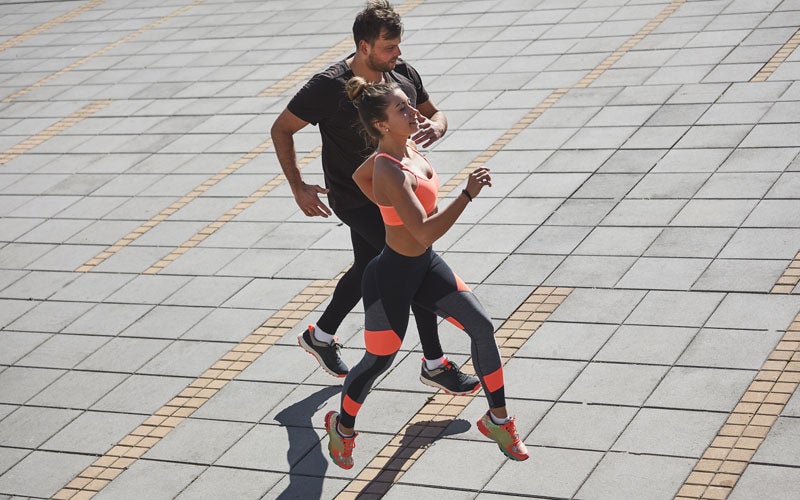Easy Running Plans to Ensure you Crush your First 30 Minutes, 5K, or 10K
 ©Maskot
©Maskot
When you’re just starting out with running, it often seems like all the experienced joggers are just floating across the ground, barely breaking a sweat even at the fastest pace.
But even they started out running short distances at a slow pace. The whole secret of learning to run your first 30 minutes is to take it slow, stay focused, and have a clear goal in mind. Our training plans will help you take those first steps. And to keep you going when the going gets tough, try drinking our Energy Aminos before your next run.
By the way: Every runner, no matter how experienced, gets out of breath during an intense workout and can have a bad day when they just don’t enjoy running. One thing is for sure: running gets easier the more you do.
Our training plans for 30 minutes, 5 kilometers, and 10 kilometers will help you reach your goal. Remember, these training plans are just a guide to get you started. How long you should run, what you should pay attention to while running, and how much time you need for recovery all vary from runner to runner and also depend on your general fitness level, as well as your physical health.
If you have any concerns, get personal advice from a coach or consult a sports physiologist before you start any exercise program.

Start Jogging: Your first steps made easy
In principle, jogging is easy: you don’t need a lot of equipment, and you just need to put one foot in front of the other. Still, running your first 30 minutes is a monotonous effort that requires your feet taking on 3-4 times your body weight with each step.
That’s why it’s worth starting slowly with a walking break and a training plan. That way you avoid both injuries from overworking yourself and losing your motivation after a few runs.
Want to run your first 30 minutes to lose some weight? Then check out our article on running for weight loss for tips tailored to your goal!
Get used to the fact that it’s not fun at the beginning.
It’s true that running releases happy hormones and those can make you feel really good after a run. But anyone who claims that it’s always like that from the very first run is lying to you.
Especially if you don’t work out regularly and want to get your fitness back on track, it takes a while for your cardiovascular system, muscles, ligaments, tendons, and everything else to get back into shape.
Even if you are otherwise athletic, and biking, working out, and being active are part of your everyday life, your body still needs some time to get used to the new strain.
Forget about longer, faster, more often.
If you want to get better at running, you just have to run, that’s true. But it’s best to go for runs that are shorter, slower, and only about 3 times a week. When you’re motivated at the beginning, it’s easy to start at too fast a pace, run a few more kilometers than you really should, and put on your running shoes again, even though you haven’t really recovered from the last training session.
But doing this risks injury and losing that motivation you had to run your first 30 minutes in the first place. Start at a moderate pace, stop after the distance set in your training plan, and stick to your training-free days. If you don’t want to sit still on that run-free day—or your legs need an extra day off from running—swimming and cycling are perfect alternatives.
Eat a balanced diet.
Running burns a lot of energy and calories. Especially if you sweat a lot, make sure you replenish the minerals you lost with a balanced diet. Complex carbs, high-quality protein, and healthy fats should be on your plate every day.
3 To-Dos Before You Run Your First 30 Minutes
#1 Figure out the right pace.
Whether you’re jogging for 30 minutes, 5K, 10K, or a marathon, the right pace is essential for keeping your body on the right track and completing a successful workout. Find the right speed for you in an easy way along with other tips here: How to Start Jogging: Everything you need to know
#2 Invest in running shoes.
Your feet do a lot of hard work when you run. Since they’re usually in shoes during everyday walking and other workouts, your foot muscles aren’t usually prepared for all that work. That’s why it makes sense to support them with shoes.
While experienced barefoot runners can cushion 3x their bodyweight with their bare feet, as a beginner runner, the cushioning in your shoes really helps you out. They protect your feet, knees, hips, and lower back from too much strain.
It’s also important to find the right running shoe for you. We’ve put together a list of what you should look out for and the best way to do it here: Finding the Right Running Shoe: Which shoe’s for you?
Find out when barefoot running is still a good idea, what advantages and disadvantages it has, and how you can, step by step, get used to more barefoot and less shoe time in your everyday life and workouts here: Barefoot Running: Your Feet Are the Best Shoes.

#3 Plan Your Warm Up and Cool Down
Warm ups and cool downs are just as much a part of running as any other sport. Simply starting running slower and coasting for a few minutes is not enough. A good warm-up prepares your muscles, your cardiovascular system, and your mind for the stress and reduces the risk of injury.
A cool down starts the recovery process, reduces the risk of dizziness and muscle cramps, and helps break down metabolic waste products like lactic acid. Get some tips for the best warm ups and cool downs for runners right here.
With these three tips in mind, it’s time to finally lace up your running shoes and get ready to run your first 30 minutes. But if you still want to procrastinate a bit, we’ve got more reading material for you: Jogging in Fall: How to get or keep your routine as temps drop
Workout Plan for 30 Minutes at Once
No matter what ambitions you have in the long run, the goal of being able to run for 30 minutes at a time is the perfect way to start.
With this training plan, you’ll learn to run your first 30 minutes in just 6 weeks. The plan is to do three workouts per week, alternating between running, walking, and walking rests, until you’re ready to take on a 30-minute continuous run.Train to run 30 minutes at once with this pdf
Workout Plan for 5K
Running for 30 minutes at a time? Great! Then it’s time for your next goal. All of the same principles still apply: distance is more important than speed. It doesn’t matter how fast you run. Before you increase your pace and work on beating your best times, it’s important to get used to longer distances.
It’s important to work with walking breaks every now and then until 30 minutes of jogging at a stretch is absolutely no problem at all.
When, at some point, you don’t care whether your run is 10 minutes, 30 minutes, 40 minutes, or 50 minutes, it’s time to check out our training plans for running 5K under 40 minutes and other more ambitious goals.Ready for 5K at once? Download me!
Workout Plan for 10K
When 5K isn’t a problem anymore, the next logical goal is 10K. In this plan, we assume that jogging for 30 minutes at a time is easy for you now and that you’ve already mastered 5K.You’ve made it this far! Time to go for 10K!
Conclusion
- Slow and steady wins the race: Increase your running times slowly. Focus on longer running times and distances before you think about a faster pace.
- Invest in good running shoes before you start running.
- Eat a balanced diet with the right amount of complex carbs, protein, healthy fats, and minerals.
More healthy living tips for runners from foodspring:
- Recovery Aminos: A treat for your muscles after your run!
- The Best Warm Ups & Cool Downs For Runners
- An All-Encompassing Guide to Mobility and Stretching for Runners
- Basic Endurance: How do you keep the pace for longer?
Sources for this article
We at foodspring use only high-quality sources, including peer-reviewed studies, to support the facts within our articles. Read our editorial policy to learn more about how we fact-check and keep our content accurate, reliable, and trustworthy.





























